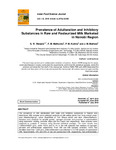| dc.description.abstract | The prevalence of milk adulteration with water and inhibitory substances in Nairobi was
determined. Milk samples were collected randomly at milk selling points from three market areas:
rural (Kiambu/Ngong’), urban (East/West of Tom Mboya street) and slum (Kibera/Mathare).
Samples were analyzed for specific gravity, hydrogen peroxide and presence of antimicrobials
using lactometer reading, peroxide strips and the Copan test respectively. Data collected were
subjected to analysis of variance using Genstat statistical package. The mean density was
1.029±0.000027 gm/L, while 16.5% and 21.1% of the milk sampled had residues of hydrogen
peroxide and antimicrobials respectively. From 206 raw milk samples collected, 13.6% had
densities lower than 1.026 gm/L while adulteration was detected in 2 of 98 samples of pasteurized
milk. Approximately 18% and 25% of raw and pasteurized milk, respectively, had antimicrobials.
The highest incidence of milk adulteration with water was in slum areas, while no adulteration was
detected in pasteurized milk. The results indicate that pasteurized milk is of satisfactory quality with
regard to adulteration with water, while raw milk marketed in Nairobi is likely to be adulterated.
Pasteurized milk was found to be more likely to be adulterated with hydrogen peroxide than raw
milk marketed in Nairobi. Therefore consumers may be exposed to residues of hydrogen peroxide
on consumption of some pasteurized packaged milk. The highest level of antimicrobials in
pasteurized milk was 33.3% in brands K.b and K.d while no residues were detected in brand K.c.
The incidence of antimicrobials in marketed milk implies that consumers are likely to be exposed to
possible drug residues. The incidence of antimicrobials in raw milk contributes to increased failures
in controlled acidification of milk during the production of fermented milk products. High incidence
of detection in pasteurized packaged milk is mostly contributed by residues of hydrogen peroxide
and/or other sanitizer or sterilizer residues. | en_US |

